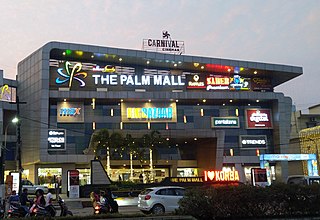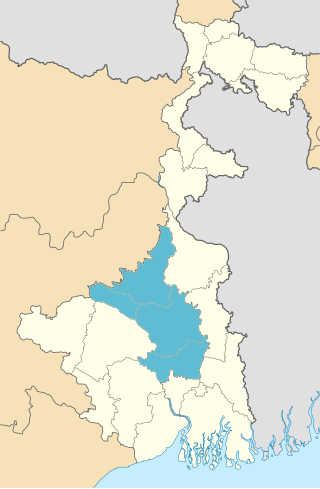
Chhattisgarh is a landlocked state in Central India. It is the ninth largest state by area, and with a population of roughly 30 million, the seventeenth most populous. It borders seven states – Uttar Pradesh to the north, Madhya Pradesh to the northwest, Maharashtra to the southwest, Jharkhand to the northeast, Odisha to the east, Andhra Pradesh and Telangana to the south. Formerly a part of Madhya Pradesh, it was granted statehood on 1 November 2000 with Raipur as the designated state capital.

Korba is a city and an industrial area in Korba District in the Indian state of Chhattisgarh. Korba was part of Bilaspur District before 25 May 1998. It was later designated as a separate district for ease of administration, but is still under Bilaspur Division. Korba is called power hub of India due to its Coal reserves and Industrial base for multiple thermal based power plants from Public sector like NTPC Limited, CSEB from State of Chhattisgarh as well as from private sector apart from Power plants Korba has the Asia's second largest and India's largest open cast coal mine in Gevra area of Korba Coalfield. Korba produces 140 Million tons of coal every year which accounts for 17% of Country's total coal production and 85% of Chhattisgarh Coal production. BALCO Private owned Aluminium producer has its smelter Aluminium Plant in Korba. Here mainly the protected tribal tribe Korwa resides. Korba district is blessed by lush green forests from all around, a large population of tribals is found here. The tribals here prefer to live in harmony with the environment in the forest area due to which they have retained their distinctive cultural characteristics and traditional practices.

Korba District is an administrative district of Chhattisgarh state in central India. The headquarter of this district is Korba.

Coal India Limited (CIL) is an Indian central public sector undertaking under the ownership of the Ministry of Coal, Government of India. It is headquartered at Kolkata. It is the largest government-owned-coal-producer in the world. It is also the ninth largest employer in India with nearly 272,000 employees.

Burdwan Division is one of the 5 administrative division in the Indian state of West Bengal. The headquarters of the Burdwan division is situated at Chinsurah while the largest city in this division is Asansol. This division is known for its huge reserve of coal, mainly in the districts of Paschim Bardhaman and Birbhum.
Dipka is a census town in Korba District in the state of Chhattisgarh, India. It is known for its Gevra and Dipka Open cast coal mines.
Korba Super Thermal Power Plant is located at Jamnipali in Korba district in the Indian state of Chhattisgarh. The power plant is one of the coal-based power plants of National Thermal Power Corporation (NTPC). The coal for the power plant is sourced from Kusmunda and Gevra Mines. The source of water for the power plant is Hasdeo River.
South Eastern Coalfields Limited (SECL) is the largest coal producing company of India. It is a "Miniratna" Company, and one of eight fully owned subsidiaries of Coal India Limited. The company has its headquarter at Bilaspur, Chhattisgarh, India and 92 mines spread over Chhattisgarh & Madhya Pradesh; 70 underground, 21 opencast, and 1 mixed. It is a schedule 'B' Mini Ratna CPSE in coal & lignite under the administrative control of the Ministry of Coal.

Singrauli Coalfield is spread across the districts of Singrauli and Sonebhadra in the Indian states of Madhya Pradesh and Uttar Pradesh, mostly in the basin of the Son River.
Sohagpur Coalfield is located in Shahdol district in the Indian state of Madhya Pradesh in the basin of the Son River. It is the biggest coalfield in the state of Madhya Pradesh.
Umaria Coalfield is located in Umaria district in the Indian state of Madhya Pradesh in the valley of the Umrer River, a tributary of the Son River.
÷Some of the more notable coal companies in Australia are the following:

The Tatanagar–Bilaspur section is part of the Howrah–Nagpur–Mumbai line and connects Tatanagar in the Indian state of Jharkhand and Bilaspur in Chhattisgarh. Part of one of the major trunk lines in the country, it passes through an industrial-mining area and handles high volumes of freight, particularly coal and iron ore.

The Jharsuguda–Vizianagaram line is a railway line in eastern India. It connects Jharsuguda,516 km (321 mi) from Howrah on the Howrah–Nagpur–Mumbai line, and Titlagarh, which in turn is connected with Vizianagaram, 820 km (510 mi) from Howrah on the Howrah–Chennai main line, and Raipur Junction, 830 km (516 mi) from Howrah on the Howrah–Nagpur–Mumbai line. There are several branch lines, like the 176 km (109 mi) line connecting Rayagada with Koraput on the Kothavalasa–Kirandul line. The line traverses Western Odisha and connects the Howrah–Nagpur–Mumbai line with the Howrah–Chennai main line. It covers small portions of Chhattisgarh and Andhra Pradesh.
The Rajmahal Coalfield is a large coalfield located in Jharkhand in eastern India.
Bokaro and Kargali Area is one of the operational areas of the Central Coalfields Limited located mainly in the Bokaro district and partly in the Giridih district, both in the state of Jharkhand, India.
Kathara Area is one of the operational areas of the Central Coalfields Limited located mainly in the Bokaro district in the state of Jharkhand, India.
Hazaribagh Area is one of the operational areas of the Central Coalfields Limited located mainly in the Hazaribagh and Ramgarh districts in the state of Jharkhand, India.
Rajhara Area is one of the operational areas of the Central Coalfields Limited located in the Palamu and Latehar districts in the state of Jharkhand, India.
Piparwar Area is one of the operational areas of the Central Coalfields Limited located mainly in the Chatra district and marginally in the Ranchi district in the state of Jharkhand, India.









